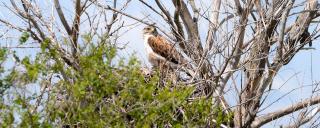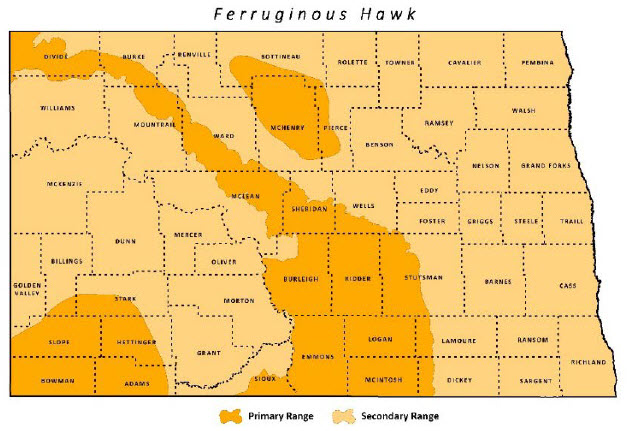
Ferruginous Hawk
| Scientific Name | Buteo regalis |
|---|---|
| General Description | L 23”, WS 56”, 3.5 lb. The largest hawk in North Dakota, it varies in coloration from almost completely white with a trace of reddish-brown, to nearly all dark brown. |
| Status | Occurs in North Dakota frommid-March to October. Peak breeding season late April to early July. |
| Abundance | Fairly common to uncommon. |
| Primary Habitat | Large tracts of native prairie. |
| Federal Status | Migratory Bird. |
| Reason for Designation | Once the most common hawk in North Dakota, the Ferruginous Hawk is vanishing from historical nesting areas. It is included on the USFWS Birds of Conservation Concern list in Region 6 and BCR 17. Partners in Flight (PIF) identifies the Ferruginous Hawk as a Regional Concern and Stewardship Species, and a U.S.-Canada Stewardship Species. |
Locations and Conditions of Key Habitat
Preferred Habitat
Ferruginous Hawks inhabit a variety of open grasslands and shrub communities. Cultivated fields, high elevations, and forest interiors are avoided. Both native and tame grasslands are utilized, as well as hayland, and pastures. Most nests are located in solitary trees, but may nest on or near the ground, in large shrubs, on utility structures, or hay bales. Will nest on hills less than 10 meters above the surrounding area and facing south or west. Primary prey includes black-tailed prairie dogs, Richardson’s ground squirrels, and rabbits. Birds are a small percentage of their diet and are fed mostly to fledglings.
Key Areas and Conditions for Ferruginous Hawk in North Dakota
The Missouri Coteau and far southwestern North Dakota may hold the highest densities of Ferruginous Hawks. Kidder County contains key habitat and possibly the greatest population of Ferruginous Hawks in North Dakota. In western North Dakota, black-tailed prairie dog towns may also play a key role in maintaining a viable population of Ferruginous Hawks.
Problems Which May Affect this Species
Habitat
Conversion of grassland to cropland, energy development and urban expansion. Degradation of grasslands from invasive plants, woody encroachment, succession, and loss of diversity. Agricultural growth has limited Ferruginous Hawk distribution to areas of uncultivated land. The loss of prairie dog towns in southwestern North Dakota and Richardson’s ground squirrel colonies east of the Missouri River due to poisoning, conversion to cropland, and other factors may also negatively affect hawk populations.
Other Natural or Manmade Factors
This species is extremely sensitive to human disturbance, will avoid nesting within 0.7 km of occupied buildings, and may occasionally be illegally killed. Disturbance of nest sites near energy development actives may reduce productivity or cause nest abandonment. Some mortality from collisions with power lines or wind turbines, or electrocution. Pesticides do not appear to be a serious threat, although illegal use of poison such as strychnine for control of ground squirrels or prairie dogs could pose a threat.
Research and Survey Efforts
Current Research or Surveys
- South Dakota State University (ND SWG T-36-R) is determining breeding ecology of Ferruginous Hawks in south-central North Dakota (Grovenburg 2005).
Previous Research or Surveys
- University of Oklahoma (ND SWG T-30-R) documented breeding ecology of hawks in relation to energy extraction activities in western North Dakota. The project was initiated in 2011 and a final report was provided in 2012. The rate of nest re-use between years was 10%, although sample size was small (n=10 nests) (Wiggins et al. 2012).
- St. Cloud State University (ND SWG T-30-R) documented basic aspects of Ferruginous Hawk ecology in North Dakota. The project was initiated in 2004 and a final report/thesis was provided in 2006. Ferruginous Hawks at the landscape scale were negatively associated with fragmentation, cropland, and woodland (McCarthy 2006).
- Gilmer and Stewart (1983) studied ferruginous populations and habitat use in North Dakota from 1977 to 1979. Of the 629 occupied nest sites visited, most (63.6%) were in trees and on the ground (20.9%). Nests on power line towers (8.0%) produced the highest nest success (86.7%). Richardson’s ground squirrel was the most common prey (65.9%). Mean number of young fledged per nest was highest in ground nests (2.8).
- Lokemoen and Duebbert (1976) studied Ferruginous Hawk nesting ecology and raptor populations in northern South Dakota in 1973 and 1974. Nests were found on the ground where there were large tracts of high quality prairie, on haystacks, and in trees of cultivated and prairie sites. The most common prey was Richardson’s ground squirrel (96%). Nest success was 63% and an average of 1.5 young was fledged.
- Numerous published reports and gray literature on this species throughout its range.
Additional Research or Surveys Needed
Explore the role of jackrabbits or other primary prey species on population fluctuations of Ferruginous Hawks.
Population and Trend Estimates
- PIF Global Population Estimate: 80,000
- PIF North American Population Estimate: 80,000
- PIF North Dakota Population Estimate: 5,000
- Survey-wide BBS Trend 1966-2012: 1.06
Management Recommendations
- Protect large tracts of native prairie.
- Do not disturb nests from 15 March to 15 July
- When converting tree communities to grassland, leave a few individual trees or mosaic of trees.
- Improve or maintain key prey species, i.e. Richardson’s ground squirrel abundance.
- Utility development should follow the guidance of “Suggested Practices for Avian Protection on Power Lines: The State of the Art in 2006” and “Reducing Avian Collisions with Power Lines” including marking power lines and creating an Avian Protection Plan.
- Wind industry companies should collaborate with the American Wind and Wildlife Institute for responsible wind development.
Monitoring Plans
According to the Partners in Flight Landbird Conservation Plan, long-term population trend monitoring such as the Breeding Bird Survey is generally considered adequate, but some issues may not have been accounted for (e.g. bias). Ensuring all BBS routes are conducted annually is priority. Monitoring plans should follow recommendations of the North American Bird Conservation Initiative ‘Opportunities for Improving Avian Monitoring’.
2005-2015 Progress
The Ferruginous Hawk remains a Level I Species of Conservation Priority. Several State Wildlife Grant Projects (T2-11-HM, T-18-R, T-20-D, T-21-D, T-22-HM, T-23- HM, T-25-HM, T-28-L, T-37-D) have contributed to habitat enhancement grasslands for Ferruginous Hawk and other grassland dependent birds. A nest site spatial database has been developed and is being used to minimize impacts to nesting hawks.

Note: A listing of works consulted when compiling the information on this page may be found in the 2015 State Wildlife Action Plan.
